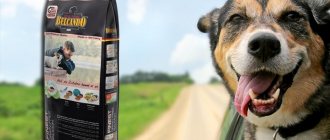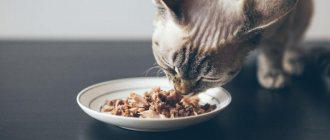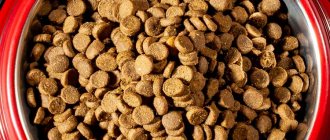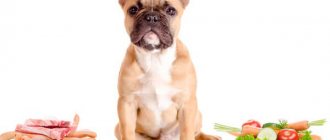May 25, 2018
In order for a four-legged baby to develop and grow well, its nutrition must be balanced. Ready-made dry diets designed specifically for dogs of a tender age help to achieve this goal without complex calculations and an endless search for healthy products. Today we will talk about how to properly give dry food to puppies and avoid mistakes when feeding them.
Advantages and disadvantages of dry food
Dry food is finely ground, evenly mixed food, prepared in the form of aromatic dry croquettes, which can have different shapes and sizes. Such products include meat, offal, grains, vegetable oils, and animal fats. The food is enriched with vitamins, minerals, amino acids, and valuable natural additives.
Benefits of dry dog food:
- Wide variety of tastes.
- Long shelf life.
- Save time.
- There is no need to calculate the daily food requirement, since responsible manufacturers always indicate the average dosage of food, taking into account the age and weight of the dog.
- Dry food can be taken on a trip or trip. Fragrant granules are an ideal treat, which are often used as a reward for obedience on walks or during training at training grounds.
- High-quality feed has a completely balanced composition in terms of the percentage of amino acids, proteins, fats, carbohydrates, minerals and vitamins.
- If necessary, you can adjust the diet, select therapeutic, dietary, therapeutic and prophylactic food.
- Dry food cleans teeth from plaque and improves the condition of gums.
Important! Veterinarians often prescribe dry industrial food for dogs during the recovery period, weakened animals, pets with systemic pathologies, and gastrointestinal diseases.
One of the disadvantages of dry food is the high cost of keeping a dog, since high-quality products have a fairly high price.
One of the disadvantages is that dogs often get used to such a diet, so if necessary, switching to natural feeding may take some time.
What should you not feed your puppy?
A puppy of any age, like an adult dog, should not be fed cold or hot food. In addition to this axiom, there is a list of foods prohibited for puppies:
- flour and bakery products;
- sweets;
- foods that cause fermentation (legumes, cabbage, plums, grapes);
- spices and herbs;
- roast;
- excess salt;
- sauces (ketchup, tomato, mayonnaise).
Important! Bones are not allowed in a puppy's diet. And not only chicken (tubular) ones. Any bones, especially when boiled, only cause harm. The exception is bone broths and sugar bones for puppies as entertainment.
Rules for selecting food
If you decide to keep your dog on ready-made diets, you must not only take into account the advantages and disadvantages of dry food, but also know the basic criteria and rules for selecting food for your pet:
- When choosing food, take into account the breed, individual, physiological characteristics (weight, dimensions), taste preferences of the pet, activity, level of physical activity, hair length. Pay attention to the animal's need for minerals, vitamins, and nutritional components.
- The food must be appropriate for the dog's age . Puppy food is not suitable for adult dogs and vice versa. Dogs of different age groups have different needs for certain beneficial substances.
- Products must have a completely balanced composition in terms of protein, fat, and carbohydrate content.
- To feed dogs, use products of the highest category and class.
- Consider the climatic features of the region and the time of year. For animals living in northern climate zones, food should be more nutritious and high in calories.
- Dry food is not suitable for feeding puppies up to 2-2.5 months , for old, elderly dogs, weakened individuals. Do not feed dry food when switching from natural to ready-made food.
- Follow the dosage portions. The daily requirement is indicated by the manufacturer on the packaging. At the same time, take into account the activity, stress, and other characteristics of your dog’s body. The dog should not overeat or undereat.
- Feed your dog products of the same brand and brand. If you need to change ready-made food, do it gradually.
- Buy products from well-known brands and brands. Do not feed your pet low-grade dry food or food consisting of bright, multi-colored granules.
When choosing dry food, you need to take into account the health of your pet. For dogs with problematic digestive tracts and weakened animals, the brands’ lines include special therapeutic and preventive dietary foods.
Diet selection
Each owner has the right to choose for his dog the diet that he considers necessary. It is important to take several factors into account:
- price-quality ratio;
- availability of food in nearby stores (or the ability to order online);
- compliance with the age and breed of the animal.
For example, food for large and giant breed puppies contains special additives to strengthen joints and is available in larger kibble. It will be problematic for dogs of dwarf breeds to chew such food, but their large brothers, on the contrary, often choke on too small particles.
Only dry food or mixed feeding: which is correct?
Many owners often ask the question on thematic forums: “Only dry food or mixed feeding: how to feed the dog correctly?”
And so, a mixed (combined) diet involves feeding pets with industrial food and natural products, or a combination of food with different structure.
In the first case, this feeding option (natural food + ready-made food), according to many veterinarians, does not bring much benefit and can cause metabolic disorders and systemic disorders in the body due to the fact that each type of food is absorbed and digested over different periods of time.
Important! If you want to treat your pet with a natural treat, give them about 6-7 hours after the main meal.
The mixed feeding option is suitable only for clinically healthy animals. Combined feeding is suitable for puppies and young dogs, but can harm older pets, individuals prone to food allergies, and those with gastrointestinal problems.
Let us note that natural products with a ready-made diet can be fed to working dogs, service dogs, and individuals with increased physical and mental stress. This type of nutrition is justified for pregnant and lactating bitches. Ready-made food can be supplemented with fruits, vegetables, berries, herbs, fermented milk products, eggs, fish, and offal.
Combination nutrition can be used if there is a need to switch the dog to a different diet, for example, from natural food to ready-made food or vice versa.
However, if you keep your pet on a ready-made diet, you should not give exclusively dry food. Combine dry granules with wet, semi-moist, canned food, pates, mousses, purees. For example, at one feeding the dog receives dried food, at another - canned food, pate, wet pieces in sauce, jelly. For feeding, choose dry and wet food of the same brand.
Can it be mixed with other products?
As mentioned above, there is no need to add additional products. Despite this, mixing with other foods is still acceptable, but not with every food.
With wet food
Wet canned food and pouches are very popular. Some owners even use them as the only feeding option, but this is completely wrong. This food was developed exclusively as a supplement for certain groups of pets:
- dogs with weak teeth;
- puppies learning to feed themselves (weaning stage);
- animals with obesity or other disorders associated with excess carbohydrate intake.
That is, canned food cannot be chosen as a monofood, but can be used as an additional food. They will reduce the load on the gums and will delight the animal with a more pronounced taste.
With natural food
This option is strictly prohibited due to incompatibility. Dog "crackers" and natural products are digested at different rates. When they are mixed, the absorption of nutrients is disrupted and rotting processes are activated. Because of this, the body is deprived of a number of useful elements, and the acidity in the stomach changes, which increases the risk of erosions and ulcers.
Classes of dry dog food
The quality of finished industrial feeds and their cost depend on the category or class.
Dry food classes:
- Economy
- Premium
- Super premium.
- Elite.
- Holistic.
High category food has a completely balanced composition, which contains everything necessary for the health and development of your pet. Remember that you can feed your dog only high-quality, high-class food.
Economy class
Economy class food is not suitable for feeding dogs, despite its attractive price and advertising. They should not be used even as a top dressing or treat, since such products are made from low-grade raw materials (technical deboned meat, offal, grain crops, soybeans, fish, meat and bone meal).
Economy feed contains dyes, stabilizers, preservatives, flavorings, and other ingredients that are harmful to animals. They are low in vitamins, amino acids, and minerals, which can cause hypovitaminosis in dogs.
Important! Economy category products have low nutritional and energy value.
Economy class feed:
- Darling.
- Caesar.
- Chappi.
- Kennel yard.
- Oscar.
- Meal.
- Our brand.
- Pedigree.
- Friskies.
Long-term feeding of cheap economy food can, over time, cause the development of serious problems and diseases of the digestive tract. Economy feed often causes food allergies and disrupts metabolism.
Premium class
Premium class feeds are popular with many breeders. Unlike economy category products, such feeds have a more balanced composition and high nutritional value. Made from natural ingredients (25-35%), but may include grains. Practically do not contain dyes or flavor enhancers. The composition is enriched with vitamins, amino acids, minerals, herbs, and vegetables.
Premium food:
- Royal Canin.
- Hill's.
- Pro Plan.
- Purina ONE.
- Brit Premium.
- Advance.
- Nature's Protection.
Premium food is a good option for a dog’s daily diet, but veterinarians and breeders still recommend giving preference to super-premium category food for daily feeding of pets.
Super premium
Super premium dry food has a 100% balanced composition. Consist of high-quality natural ingredients (calf, lamb, poultry, rabbit). Contains grains in minimal quantities. Enriched with vegetables, herbs, and all necessary nutrients.
Important! If a puppy receives high-quality professional food, he quickly grows, develops, gains muscle mass and the necessary condition.
Super premium food:
- 1st Choice.
- Nutram.
- Eukanuba.
- Trainer.
- Monge.
- Dukes Farm.
- Brit Care.
- Gina.
- Porcelan.
- Bosch.
- Optima Nova.
- DailyDog.
The composition of premium category products of various brands differs little in the content of main ingredients and vitamins. Therefore, when choosing a diet, take into account your pet’s taste preferences, his age, weight, and activity.
Holistic
Holistic food is the best you can offer your pet. Holistic products are made exclusively from natural ingredients. Contains probiotics, enzymes, vitamins, amino acids, minerals, herbs, vegetables, berries, as well as substances that improve metabolism and digestion.
This category of feed does not contain any harmful substances, chemical compounds, by-products, or soy. All components of the food are perfectly balanced.
Holistics for dogs:
- Acana.
- Savarra.
- Now Fresh.
- Orijen.
- Canidae
- Grandorf.
- Go Natural holistic.
- Summit.
- Holistic Blend.
- Farmina N&D.
- Pronature Holistic.
Holistic dry food is complete and provides the animal’s body with all the necessary substances. Ideal for puppies, weakened pets, individuals with a sensitive digestive tract, dogs who are often diagnosed with nutritional allergies.
Is it possible to change a dog's diet?
The easiest way to feed a pet is to use ready-made dry food and canned dog food, but in many cases, owners resort to preparing cereals themselves, with the addition of vegetables and meat. Each option has its advantages and disadvantages, but when changing your pet’s diet, you should definitely consider certain recommendations.
Switching from natural food to dry food
With prolonged feeding of “natural” food, the dog’s digestive system is adjusted to digesting cereals, vegetables and meat, which often takes a little longer than in the case of feeding ready-made dry granules.
The owner can change the diet of a pet at any stage of its life, but only if the following conditions are met:
- You cannot change porridge to dry food in one day. Typically the adaptation process takes at least two weeks. The usual amount of feed should be divided into seven parts. In the first two days, the dog is given six parts of natural food and one part of the selected dry food. On the third day, the pet is given 2 parts of dry granules and 5 parts of natural food, continuing to reduce the amount of natural food used with each subsequent day.
- At first, it is advisable to soak hard dry granules in water, due to which they will become more similar to the semi-solid food familiar to the dog.
- Before introducing food into the menu, it is important to take into account the animal’s total daily food intake, calculating exactly how many vegetables, cereals, meat, offal and fermented milk products the pet eats. In the future, this will help calculate the required amount of vitamins and minerals.
- You should not mix ready-made and self-prepared food. It will be better if the dog eats dry food in the morning and has the usual porridge for dinner. A sudden change in menu or the simultaneous consumption of different foods by your pet can lead to disruption of the digestive system and even stress.
Important! Don't buy a large bag of food until you are sure your dog will eat it. Some owners have to go through several brands until they find a product that is ideal for their taste.
Young and completely healthy dogs usually tolerate a change in diet without problems, but if the animal has problems with the gastrointestinal tract or other health problems, it is better to discuss such a decision with a veterinarian. A specialist will help you choose the most suitable dry product, possibly with medicinal properties.
Changing the brand of dry food
The modern market offers food from a variety of brands, so deciding which dry product is best for a particular dog is not always easy. Some dogs immediately reject all the options offered by the owner, others change their taste preferences after several years of consuming the same dry product, but in any case, its change should be smooth, taking into account the following scheme:
- From the first to the third day, only 25% of the usual food changes, leaving 75% of the food already familiar to the pet.
- From the fourth to the sixth day, the share of new food in the diet increases to 50%.
- Starting from the seventh day, the amount of newly purchased food can already be 85% of the daily volume of food, and from the thirteenth day a complete transition to a new diet is allowed.
Granules of the already familiar and new food are mixed together before each feeding, although, if desired, the owner can prepare a small amount of dry food for several days, distributing the ratio as above. If, after several days of a new diet, your pet experiences a disorder in the functioning of the digestive system, it becomes lethargic and completely refuses food - it is better to consult with a veterinarian and not rush into further introducing a replacement product into the diet. Until it is possible to determine the true cause of the problem, it is better that the share of new food is no more than 10% of the total daily food volume.
In addition, when deciding to change the brand of dry food, it is worth considering some other recommendations:
- You should not replace products from an expensive line with options from the cheap segment; it is best to feed the animal with super-premium or premium food.
- Under no circumstances should you exchange dog food for cat food, even if the dog happily eats its neighbor’s food.
- When choosing a dry product, be sure to take into account the age, activity level and size of your pet, because food for sedentary large breeds is not suitable for an active lap dog.
- A bowl of water should be freely available to the dog, regardless of the season and weather conditions.
Did you know? Approximately 10% of domestic dogs are able to recognize signs of epilepsy in their owners. This helps to take all necessary measures in a timely manner to reduce the intensity of the attack.
Often, inappropriate dry food becomes the main cause of problems with the dog’s skin and gastrointestinal tract, and the owner does not always immediately discover the true cause of the existing disorder. First of all, the owner should be alert to the following symptoms:
- persistent bowel disorder: diarrhea or frequent constipation;
- large volumes of feces, that is, as much as the dog eats, so much comes out during defecation;
- a change in the normal color and odor of stool (usually it becomes greenish or gray and has a strong foul odor);
- causeless itching in the anal area or anywhere else on the body, with loss of the natural shine of the coat (animals often scratch their ears);
- increased tearing and redness of the whites of the eyes, especially if their appearance coincides with a change in food.
The systematic manifestation of all of the above disorders requires their immediate solution, otherwise there is a serious likelihood of the appearance of a chronic form of disease, which is much more difficult to cope with.
Feeding standards
The daily requirement depends on the age, weight, breed, and size of your dog.
Manufacturers indicate on the packaging the average daily dosage, taking into account the weight and age of the dogs. Remember that the standards stated on the packaging are just a guideline, since the individual physiological characteristics and needs of a particular individual are not taken into account.
Serving Size
The serving size is selected individually for a particular animal and primarily depends on the age, breed of the dog, as well as on the energy value and calorie content of the food.
Economy feed has 260-320 Kcal, premium – 320-365, super-premium – 360-450 Kcal, holistic – 370-430 Kcal. Therefore, the serving size when feeding premium, economy products will be larger than when feeding a dog with premium food.
Puppies' portions are smaller than those of young, adult animals. At the same time, the daily food intake for puppies up to 6-7 months exceeds the norm for adult dogs by approximately one and a half times.
The daily dosage of food for dogs of large, giant breeds is higher than for representatives of small, decorative breeds.
Divide the recommended daily intake, which is stated on the packaging, into equal parts in accordance with the number of feedings. Do not use a double dosage for feeding, since puppies, especially large, giant breeds, do not always know the measures and often transmit, which ultimately ends in vomiting and other disturbances in the functioning of the gastrointestinal tract.
Dry food is concentrated, so satiety occurs a little later than the dog eats its portion. Even if the dog begs for more or treats after eating, do not follow his lead.
Important! Determining the amount of feed “by eye” is unacceptable. Use kitchen scales and measuring containers. After eating, the dog's bowl was empty.
Exceeding the dosage by 20-25% of the recommended is permissible only for working dogs, sports dogs, lactating and pregnant bitches. A reduction in the daily dosage is possible in case of obesity, excess weight, or according to the indications of a veterinarian.
Feeding frequency
The frequency of feeding depends on the age of the pet. Puppies are fed in small portions (4-6 times a day), but often at regular intervals. Adult dogs are given food once or twice a day.
Train your dog to a certain routine. Give food at the same time. Compliance with the regime and daily routine is the key to excellent health and well-being of your pet.
Portion volume
The entire recommended daily diet for a dog should be divided equally into several meals. Their number decreases as she grows older. You cannot give your puppy a daily portion at one time: he will eat more than he should and will suffer from abdominal pain or vomiting.
Expert opinion
Anna Abramenko
An avid dog lover. Experience in veterinary medicine since 2009.
Ask a Question
Newly born babies should receive food (breast milk, formula) approximately every 3 hours for 1 month, 7-8 times a day. Complementary feeding of three-week-old litter puppies begins with a very small amount - 1 teaspoon per day. Gradually, an increasing amount of new food is introduced, unless a negative reaction of the body occurs in the form of allergies or digestive disorders.
A puppy at 2 months is fed 5-6 times. At the same time, at least 4 main meals consist of dry food. After 3 months, it is enough for a puppy to eat 4 times a day, from six months - 3. From 1 year, the owners transfer their pets to 2 feedings a day, although for some dogs 1 meal is enough.
Determine the serving size using measuring cups, spoons (may be included with the food package) or kitchen scales.
For example, with a daily intake of 660 grams, you need to give a 7-month-old puppy 220 g at each meal.
If your dog constantly leaves some of his food uneaten and is growing well, his portions should be reduced. Feeding more than the recommended norm is possible if the puppy lags behind its peers in weight and height.
Water consumption rate
The rate of water consumption does not depend on the dog’s diet. Water should always be available in unlimited quantities. The bowl should always be full. On average, a dog should drink 50 g of water per kilogram of weight per day.
The amount of liquid consumed by a pet depends on the diet, season of the year, activity, health, and age. Unlike canned food, dried pates contain no water at all, so the dog may feel thirsty after eating.
Use filtered, settled, clean drinking water for your dog. Change the water two or three times every day.
Should you give your dog a treat?
Of course it's worth it! And in some cases, for example, during training, this is simply necessary, as it provides positive reinforcement that is simple and understandable to the dog.
Another question is what to treat and in what quantities. There is no need to give sausage, ham, sausages and other delicacies from the table: they will bring nothing but harm to the dog. Products intended for people contain quite a lot of components that are harmful to dogs: spices, herbs, quite a large amount of table salt, etc.
Never give your dog sweets, especially chocolate. Cocoa beans contain theobromine alkaloid, which causes poisoning in animals.
You can treat your dog with boiled meat without salt or a piece of boiled egg; some animals love raw carrots or apples - this is also not forbidden. You can purchase high-quality dry or cured meat treats at pet stores - this is the most convenient option for training, as they are easy to put in your pocket.
The main thing is to remember that although treats are not a complete meal, they also contain calories, so getting carried away with treats can easily cause your dog to gain excess weight. To prevent this from happening, follow the rule - the volume of treats should be no more than 10% of the daily diet dogs.
So, for example, if the dry food feeding rate is 300 g per day, then you can offer your dog no more than 30 g of dry treats or about twice as much wet treats, including natural products.
Features of feeding puppies
Have you got a puppy and are you planning to keep him on a ready-made diet? In addition to choosing high-quality food, you need to know the features of dry feeding puppies.
Puppies can be given their first complementary foods starting from 3-4 weeks. Use specially developed mixtures, mousses, pates for puppies. The dog will be able to eat hard granules no earlier than 2.5-3 months.
Puppies can be accustomed to drying from the moment their baby teeth appear. At first, soak the granules in warm water, kefir, milk, and whey. Food should have a pasty, porridge-like consistency.
As the puppies grow, the consistency and density of the food changes. The transition should be gradual. Monitor the condition of your pet, its well-being, and the consistency of its stool.
When picking up a puppy from a breeder, be sure to ask what they used for complementary foods. Feed the dog the same food and products for the first two weeks. A sudden change in diet is stressful for a dog’s body. If the puppy received natural products, the transition to a ready-made diet will take 9-14 days.
Small breed dogs require approximately 300-400 g of food per day. The volume is divided by the number of feedings. For puppies and young dogs of medium breeds - 450-620 g, for puppies of large, giant breeds - 750-910 g.
Graduality
Having chosen the optimal food for your little four-legged friend, do not rush to switch to it. For the first 10–15 days after arriving at a new home, it is better to feed him the food to which he is accustomed. Usually, breeders themselves tell the buyer the name of the food they fed the puppy, and the most responsible ones even give a small bag with them.
As soon as the baby adapts to the changed conditions, you can transfer him to the product that the owner prefers. The transition should not be abrupt.
- Replace about a quarter of the serving with new food, leaving the total calorie content the same;
- Every day, increase the share of the new product, proportionally reducing the amount of the old one;
- After 5-7 days, completely switch the puppy to the chosen food.
A gradual transition to another food helps to avoid stress and digestive disorders, as well as monitor unwanted reactions of the animal’s body to a new type of feeding. The signal to suspend food “reforms” should be stool upset, allergic reactions: rash on the stomach, itching and excessive discharge from the ears.
Features of large and small breeds
When feeding dry food, owners should know the characteristics of large and small breeds. Manufacturers in their lines have products for small, medium, large, and giant dogs. There are also ready-made diets designed to feed dogs of certain breeds.
Small breeds and small dogs are active and energetic even in adulthood. Unlike large breeds, they have a faster metabolism, so the daily diet may be slightly larger in relation to body weight than large dogs.
Do not forget that small dogs are prone to allergies and obesity, so do not exceed the daily dosage specified by the food manufacturer. For feeding, choose holistic, super-premium food, food marked “Mini”.
Small dogs can be easily accustomed to a certain type of dry food, but remember that representatives of decorative breeds are quite picky eaters. Therefore, choose the optimal ready-made diet, taking into account the taste preferences of your four-legged friend.
To feed large active, working, service dogs, choose food marked “Active”, “Energy”, “Premium”, “Superpremium” or any other good food for large breeds. Foods for large dogs have high nutritional value, but lower calorie content. Must contain vitamins, minerals, amino acids, biologically active substances.
Important! The calorie content of the diet depends not only on size, weight, breed, but also on the level of physical and mental stress. Working, hunting, service, and hyperactive dogs should receive a more nutritious, high-calorie diet.
Regardless of size or breed, the finished diet should be nutritious, fortified, and balanced.
The perfect solution
To avoid allergic reactions and other problems, be sure to consult your veterinarian. He will help you choose a safe and balanced diet based on your dog’s tests.
When introducing adjustments, you should be guided by a similar decision. Tests must be taken at least once a year, and with the onset of old age and in the presence of chronic diseases - every six months.
Remember that there are a lot of animals with allergies and sensitive digestion. If signs of an allergy have never appeared before, this does not mean that it does not exist. For this reason, you should discuss with your doctor not only the caloric content of the diet, but also the composition of future granules.
How to properly soak dry food
Dry food is soaked for puppies up to 3 months of age, when switching from natural food to a ready-made diet, during the period of changing baby teeth. Also soak the dryer before feeding older pets or if the dog has problems with teeth, gums, or inflammation of the oral mucosa. Let's look at how to properly soak dry food.
Dry granules are soaked in warm drinking water (50-60 degrees) in a ratio of 1/2 or 1/3. The higher the water temperature, the faster the dryer will soak. You can also use milk, kefir, whey.
If the pet refuses to eat the dry food offered, the dry food can be soaked in low-fat fish or meat broth for the first time.
Important! The dosage does not change, even if you soak dry food.
Make sure that the dryer, soaked in water, kefir, or milk, is eaten by the dog within 2-3 hours, as the food becomes chapped, sour, and contaminated with harmful bacteria.
How to feed one-week-old puppies without a bitch?
Unfortunately, there are situations when the owner has to take on the role of the puppies’ mother, feeding them artificially. Feeding newborn puppies is not easy - you will have to devote all your time to this. Don't know how often you'll have to feed your babies? This will have to be done every two hours.
There are several options for feeding a puppy/puppies left without mother's milk:
- The easiest way to purchase is the so-called “bitch milk”, which is sold in powder form in packages of different capacities. The selected ingredients are as close as possible to the composition of the bitch's milk.
- The second option is to make your own formula for feeding puppies if you have cow's or goat's milk. To do this, take 3 yolks, a pinch of salt, a quarter teaspoon of vitamins (liquid) and a spoonful of corn oil per liter of milk. This mixture is brought to 35°C and fed to the puppies using a bottle with a pacifier. Babies are fed this way for up to three weeks, after which crushed regular food is gradually introduced.
If the dog lives on the street
If a dog lives outside or is kept in an enclosure, its diet should contain more fats, proteins and vitamins to support the immune system. In general, the nutrition of dogs that live on the street differs little from dogs living in a house or apartment. Minor adjustments to the prepared diet are carried out in different seasons of the year. Feeding animals in summer differs from feeding them in winter.
Feeding in summer
In summer, especially during hot periods, dogs may experience a slight decrease in appetite. If your pet constantly leaves food in the bowl, it is permissible to slightly reduce the daily amount, by about 10-15%.
In the summer months, dogs need more wet, semi-moist, canned food, since they contain more moisture than dry food and dogs eat such products more willingly. In this case, the dog must always have access to water.
Feeding in winter
Feeding dogs in winter means a more nutritious, high-calorie diet. Particular attention to nutrition in winter should be paid to individuals who are involved in work, are exposed to physical stress, take part in competitions, or are kept in enclosures all year round.
For feeding, use food marked “Active”, “Energy”, “Super-premium”, holistic.
The prepared diet can be supplemented with vegetable fats, vegetables, high-quality offal, and fermented milk products, if there are no contraindications.
Owner reviews
Julia, Ufa:
The Perfect Fit food was recommended to us by a veterinarian. My dog liked the diet and eats with appetite. In addition, the dog was overweight, but now we are in good shape thanks to this food, always energetic and healthy. Now we only buy it.
Natalya, Novosibirsk:
Four months ago we picked up a puppy on the street. The question immediately arose: “What to feed?” Homemade food was absolutely not suitable for him, and we couldn’t afford very expensive food. Perfect Fit was a godsend for us - balanced, with a good composition. The dog began to gain weight well, his fur began to shine, and he became more active. There is no repulsive smell from the mouth. A veterinarian I know said that with this food the dog’s teeth will be fine. We have been buying this food for several months now and have no plans to change it yet.
Stick to one type of diet
Sometimes the owner does not regard dry food as a complete diet for the puppy and strives to add something to it: meat products, canned food, food from his own table. We do not recommend doing this, and here's why.
- By practicing mixed feeding, you lose the main advantage of dry food - balance. By constantly changing products, you will never know exactly how much a puppy receives of a particular nutrient or whether it is enough for him.
- Wet food smells more intensely than dry kibble, so given the choice, many dogs prefer it. Knowing that there is an opportunity to get a piece of meat, the puppy may refuse dry food altogether. Consider whether this is part of your plans.











